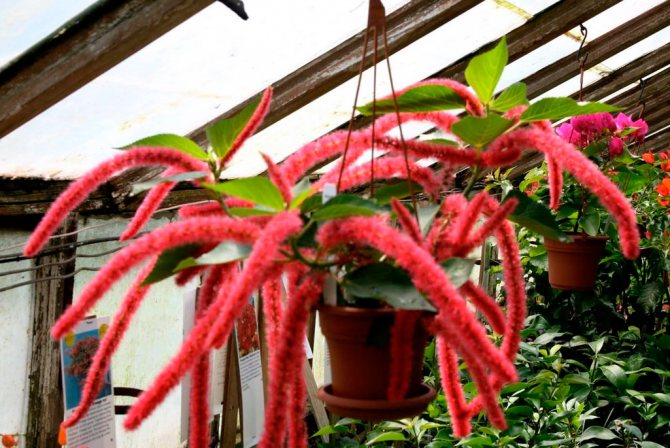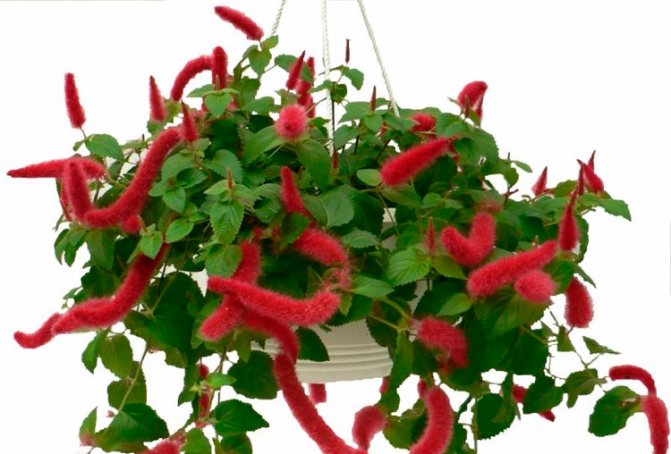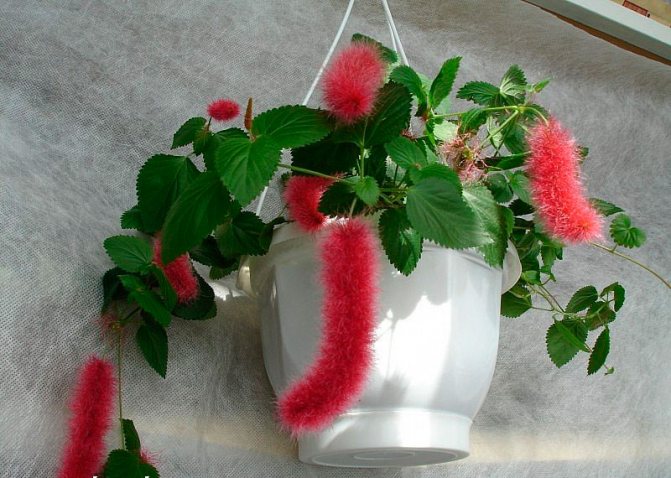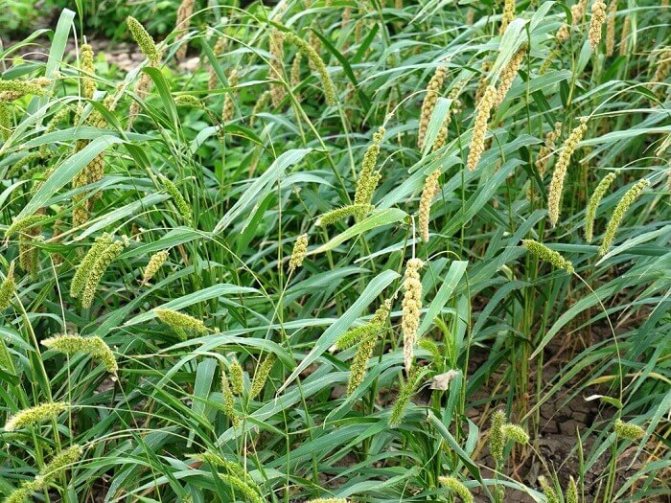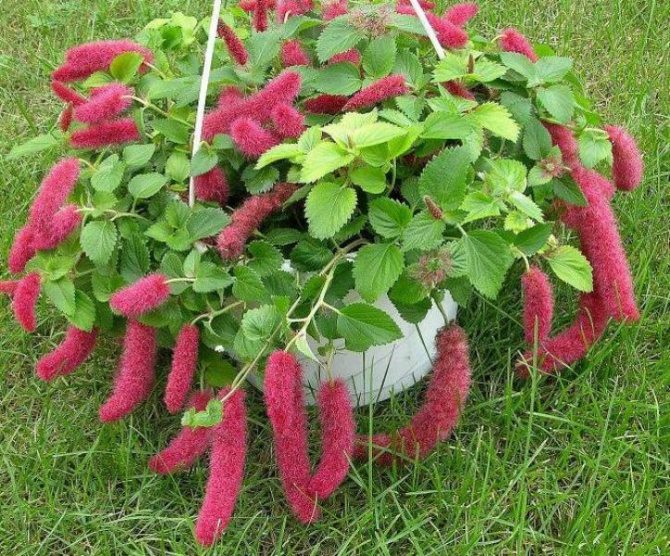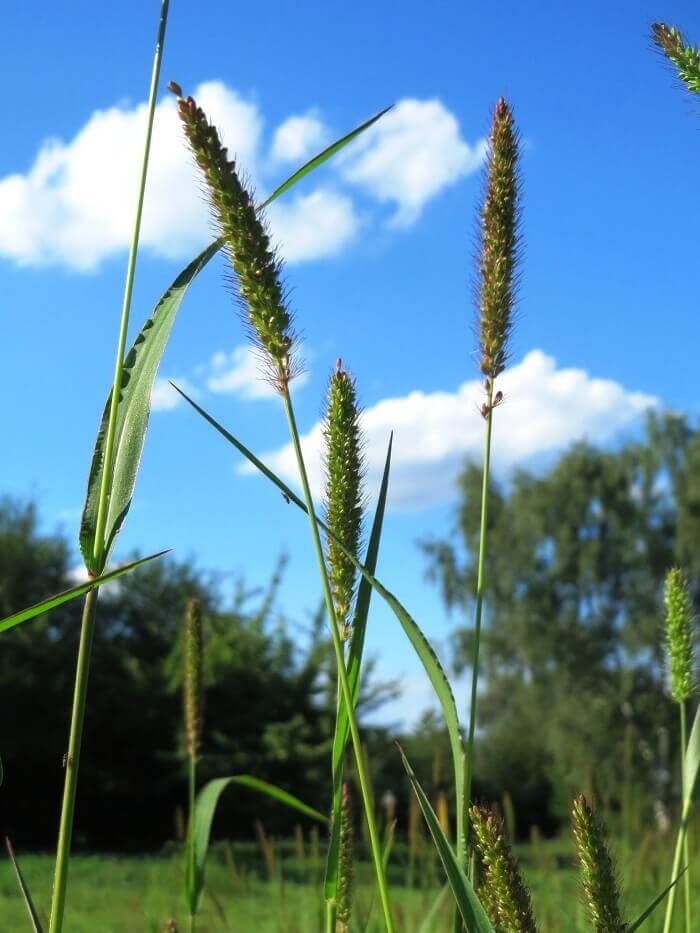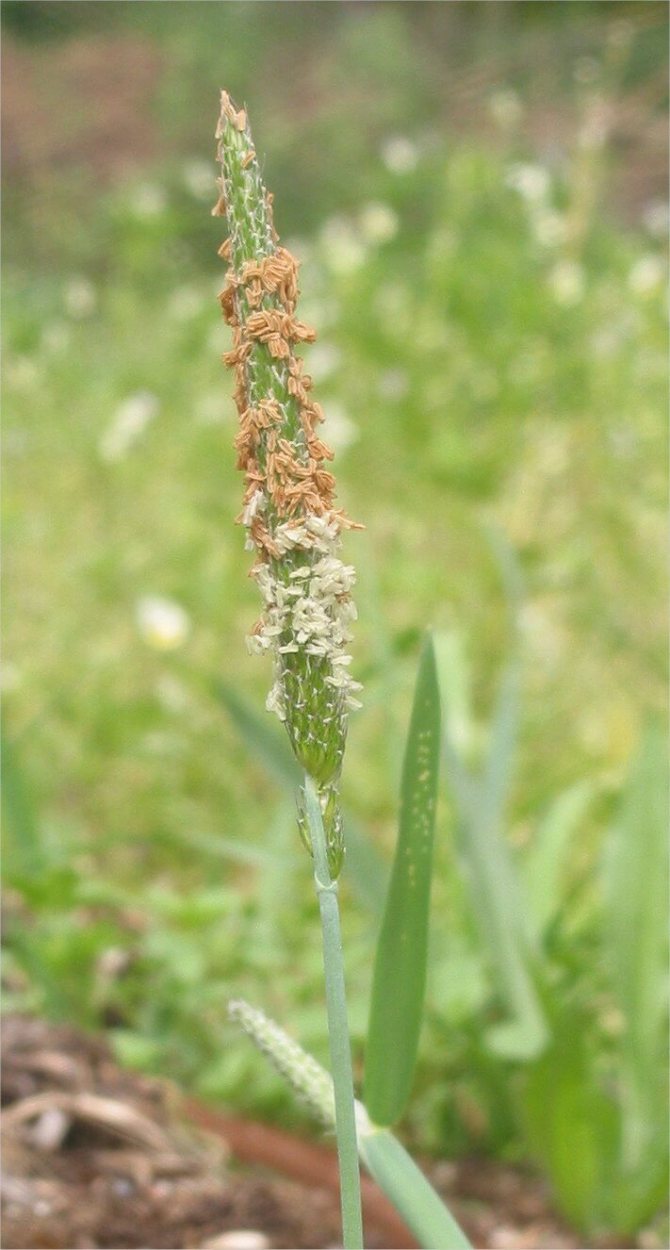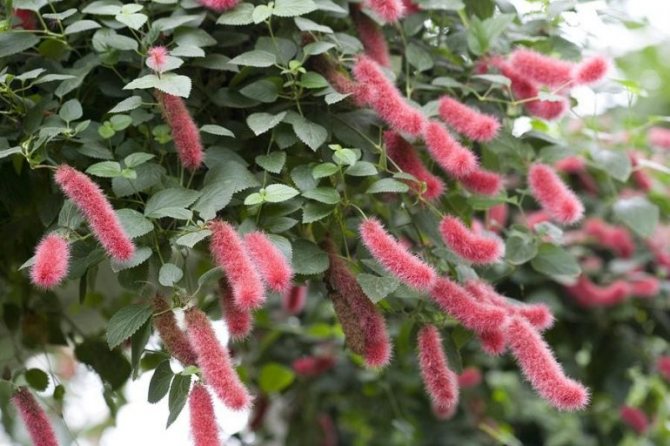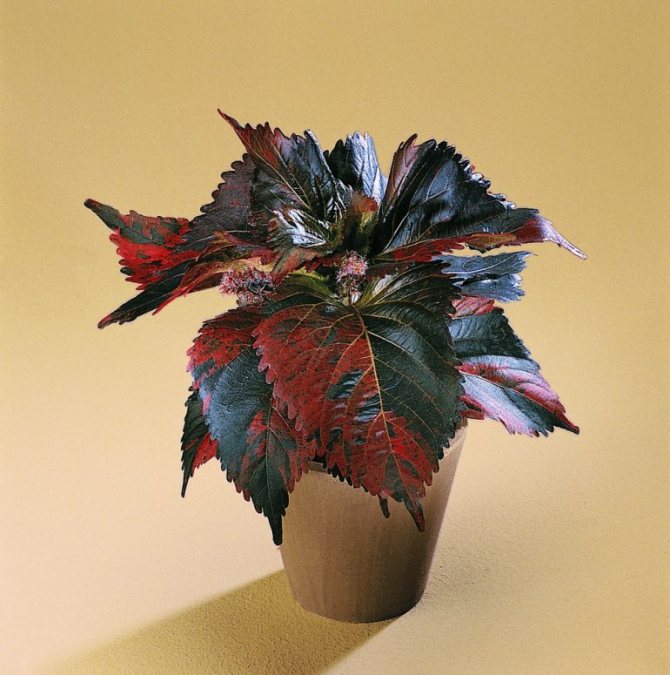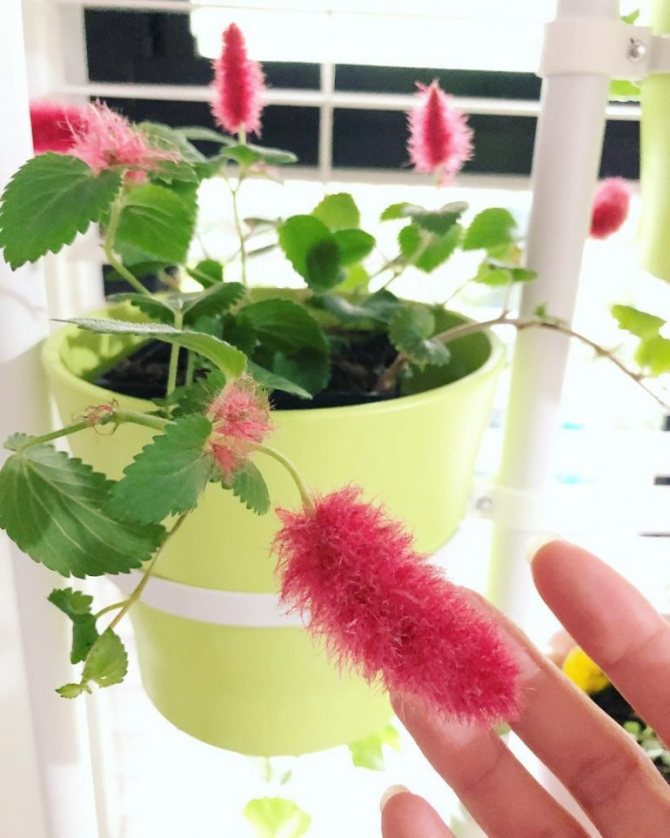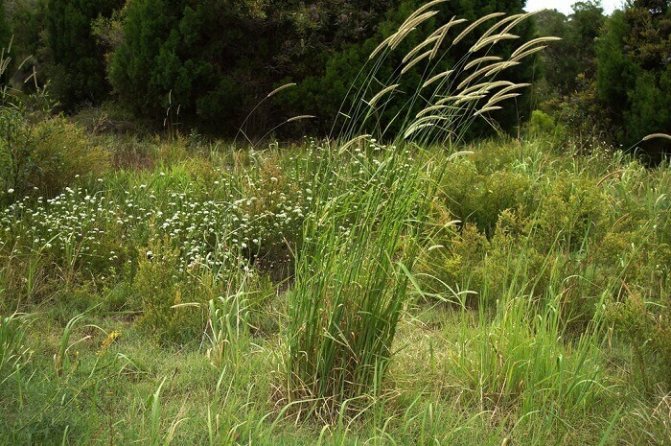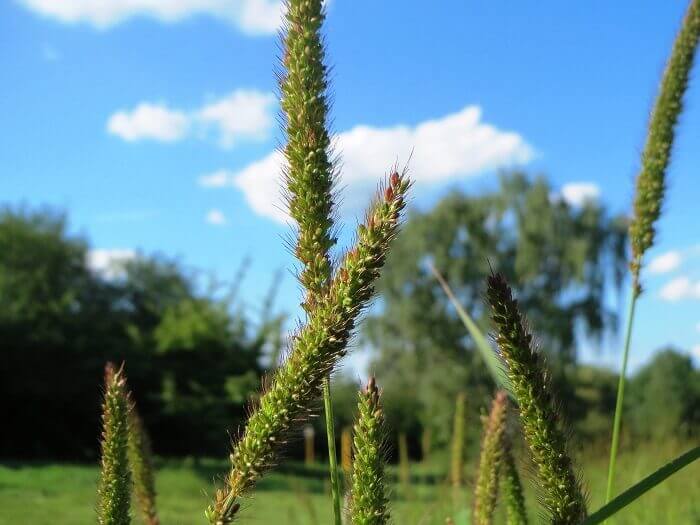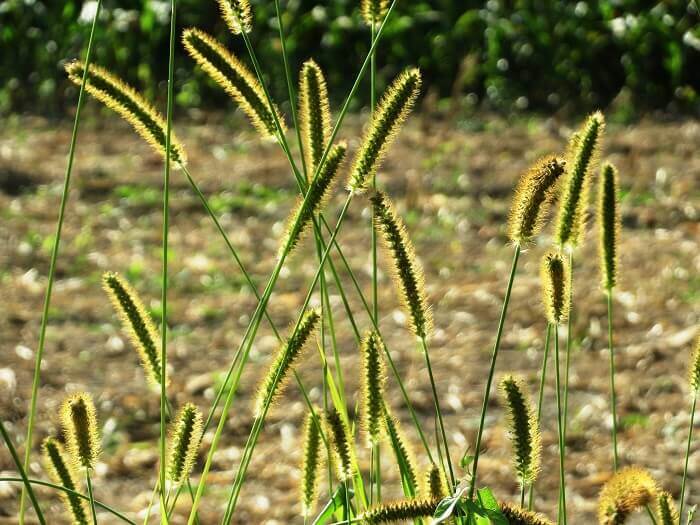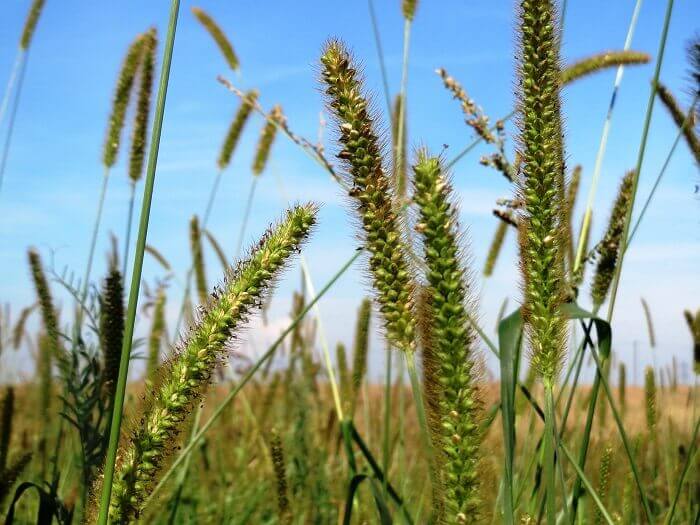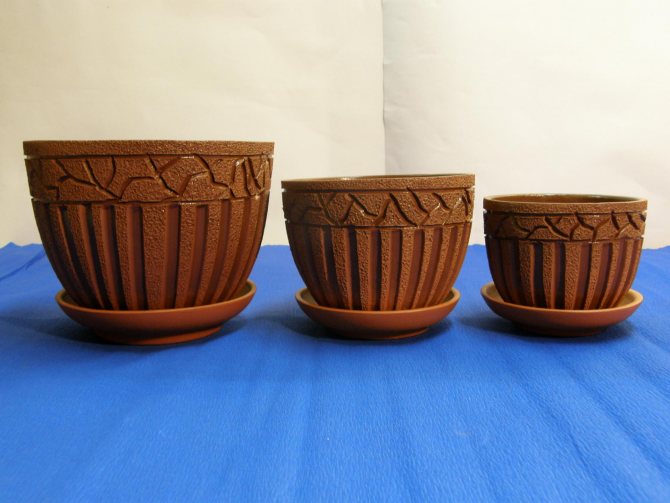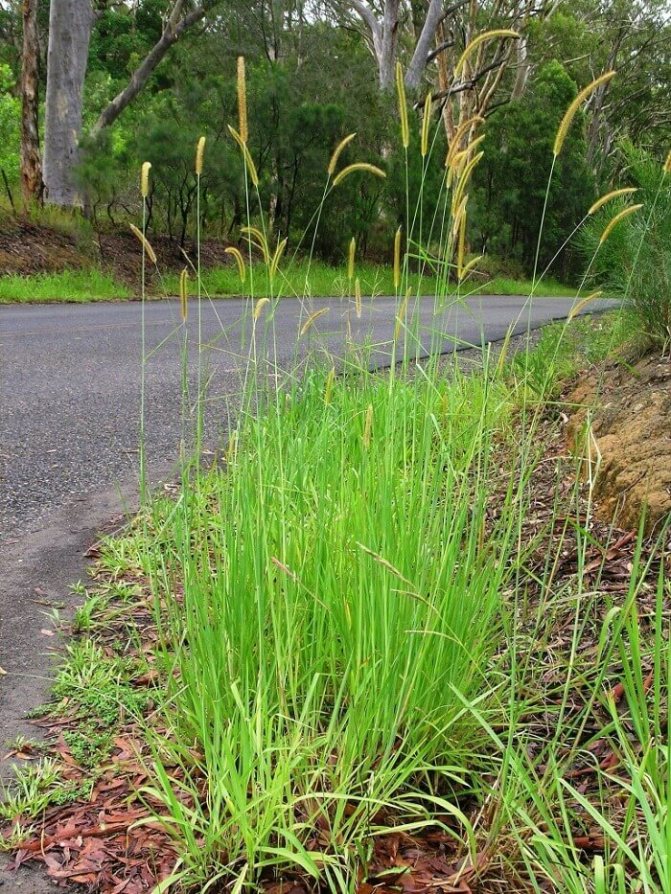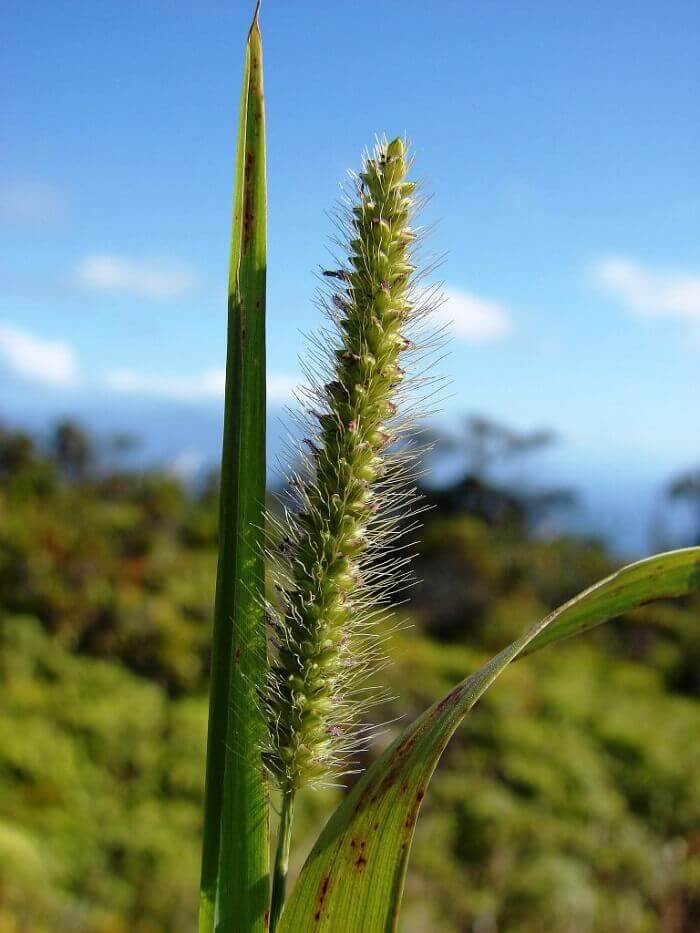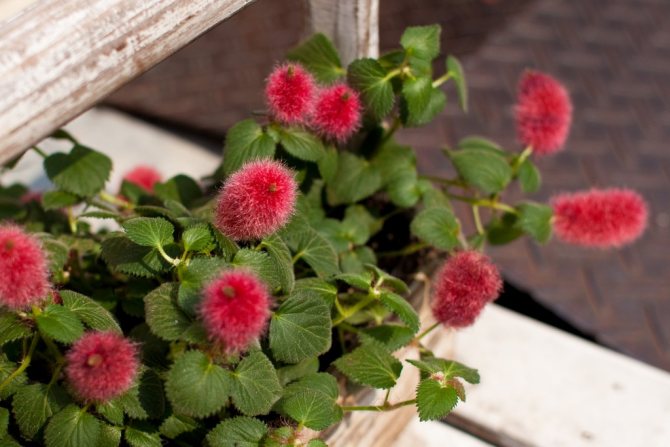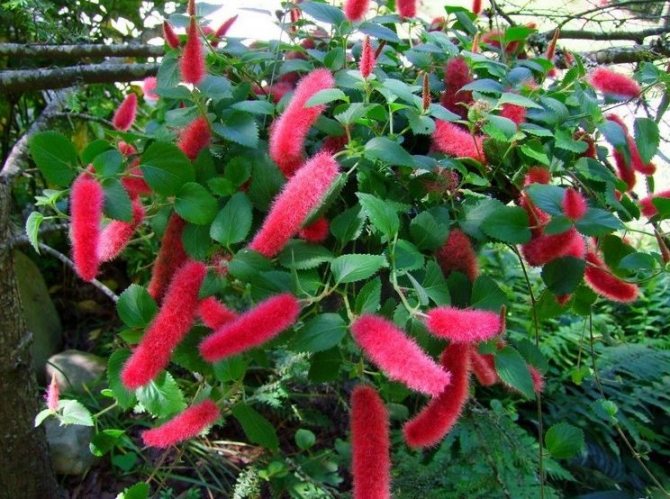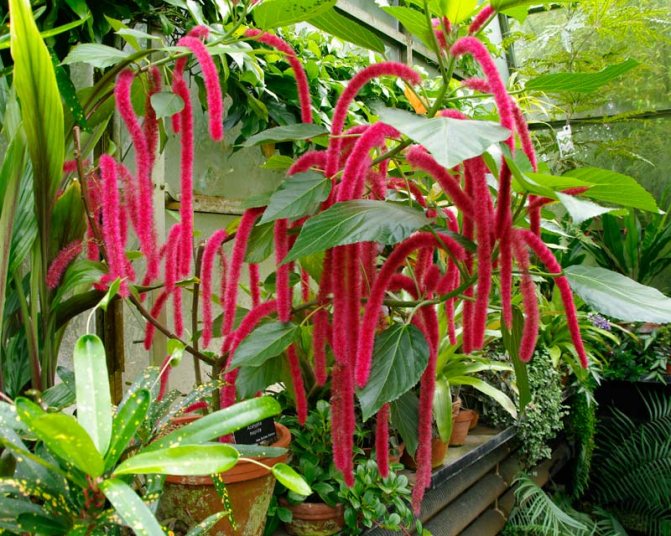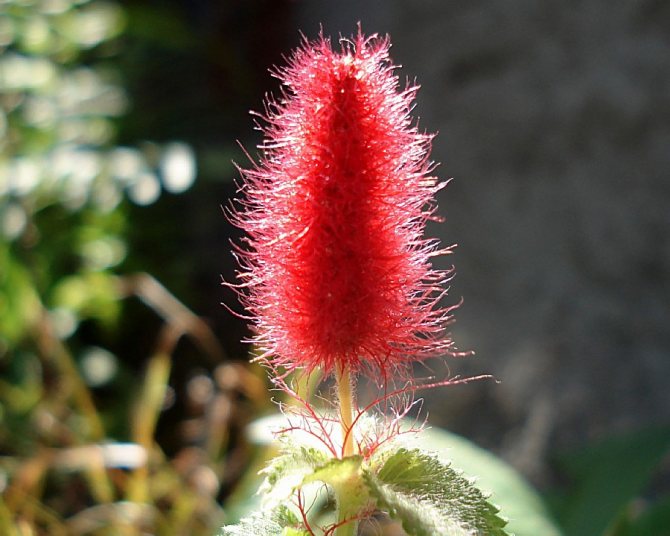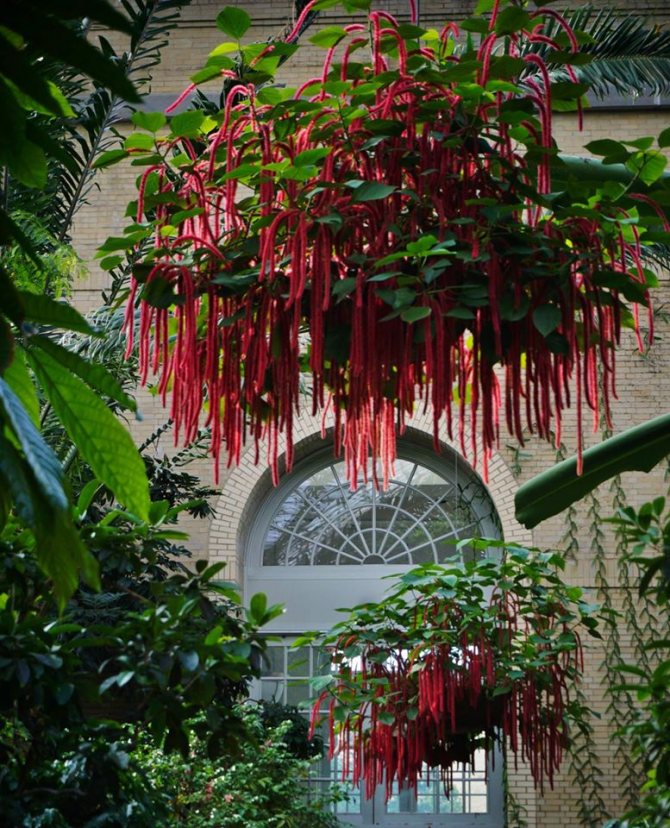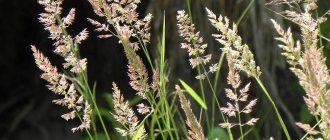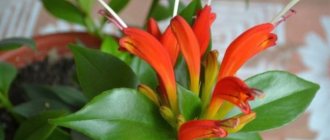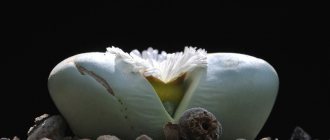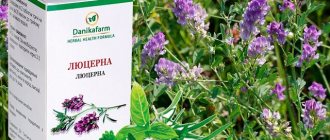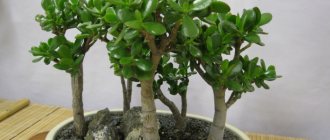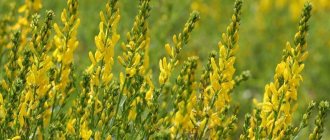Akalifa is a prominent representative of the Euphorbia family. Under natural conditions, it is found in the tropical rainforests of Southeast Asia, it grows on the islands of the Pacific Ocean. There are about 250 species of this plant in the genus. Translated from the ancient Greek language, Akalifa means nettle. There is a deal of truth in it. The leaves of the plant bear similarities to burning grass. In its natural environment, Akalifa is a lush shrub, which, during flowering, is covered with beautiful hanging inflorescences, similar to a fox's tail. For this feature, the people call the plant Foxtail.
In indoor conditions, fox tail began to be grown in 1898. Akalifa is compact in size, does not grow taller than 30-70 cm under home conditions. Many growers grow it as an ampelous plant in a hanging planter or basket.
In apartments, the most common Akalifa is bristly-hairy. Its characteristic feature is the ovoid leaves with serrated edges. It should be remembered that Foxtail belongs to poisonous plants. It is not recommended to breed it in a house with children and pets. In indoor floriculture, another species is grown - Akalifa Wilkis. The plant is loved for its attractive decorative leaves with a nondescript flowering. It does not impose any special requirements for the care of its owners, so even novice florists can grow it.
Features of the meadow foxtail culture, plant care
Meadow foxtail is a perennial herb, with a height of 50 to 110 cm. The leaves are flat, with a sharp-rough structure. This plant has such advantages as: winter hardiness, aftermath, high nutritional value and resistance to waterlogging. Foxtail is often used as a precursor for cereals and vegetables.
The plant has a fibrous rhizome that penetrates the ground to a depth of one meter. The leaves are about 25 cm long and have a slightly bluish color. Meadow foxtail became famous in the 18th century. To date, five breeding varieties have been zoned. The seeds of the plant are scarious and non-flowing. The mass of 1000 seeds ranges from 600g.
Reproduction
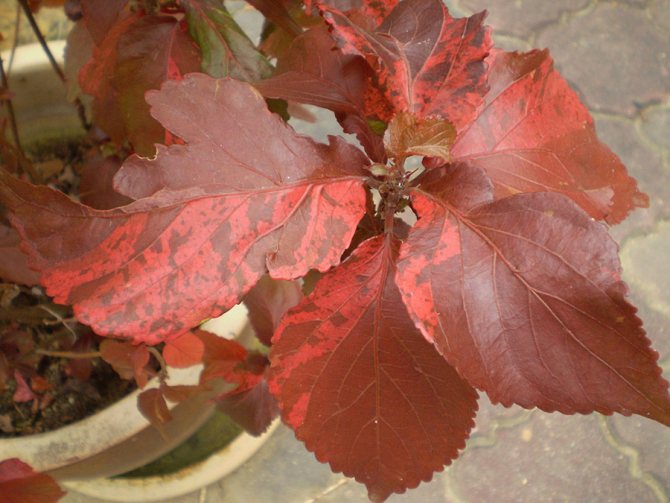
Akalifa propagates by cuttings. In early March, pour drainage and light soil into a pot with a diameter of 8-10 cm. Cut off the top of the stem as long as your index finger, leaving 2 pairs of leaves and an intact growing point. Make a cut under the leaf node. Remove the lower leaves. Powder the slice with Kornevin to stimulate root formation.
Use a sharp stick or pencil to make a depression in the soil, place the cutting vertically and gently compact the soil around it. Water well and cover with plastic. The cuttings will be grateful for the diffused light, warmth and daily airing. Transfer the rooted and grown plant into a pot 2-4 cm more.
Foxtail is also grown from seeds that are sown in early spring. The soil is prepared from a mixture of river sand and leafy earth, taken equally. To obtain seedlings, a constant temperature (+ 20-22 ° C) and high humidity are required. Transfer young plants to a soil made up of equal volumes of river sand, turf and leafy soil.
The main features of culture
After sowing a crop, at first it grows very slowly.The first shoots begin to appear only 12 days after sowing. In the first year, a small number of fruiting shoots appear. Already in the second year, foxtail begins to actively grow and develop. With the onset of June, cereals begin to bloom. In this type of cereal crop, there are signs of both spring and winter development. In other words, we can say that meadow foxtail is a semi-winter type of culture.
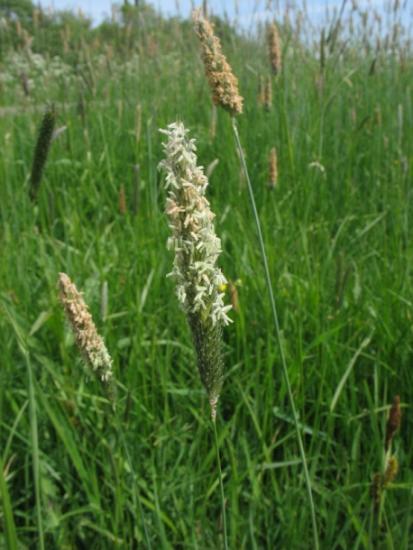

The grains of the plant can be stored for more than ten years, and the seeds for about four. The flowering period of the plant is slightly extended. This is due to the non-simultaneous ripening of the shoots. Since foxtail is a moisture-loving plant, it is best sown in clay meadows and low-lying peatlands. It can also be grown in acidic soils. Due to the high winter hardiness of the culture, it is sown even in areas of the forest-tundra.
Variegated vegetables
There are very few colorful vegetables with painted leaf blades and yellow, white petioles, but they are very interesting, and therefore are in demand in combined plantings with flowers in a creative dacha. To show such vegetables and delight friends - it will be, in the language of modern youth, cool!
Corn, variegated varieties
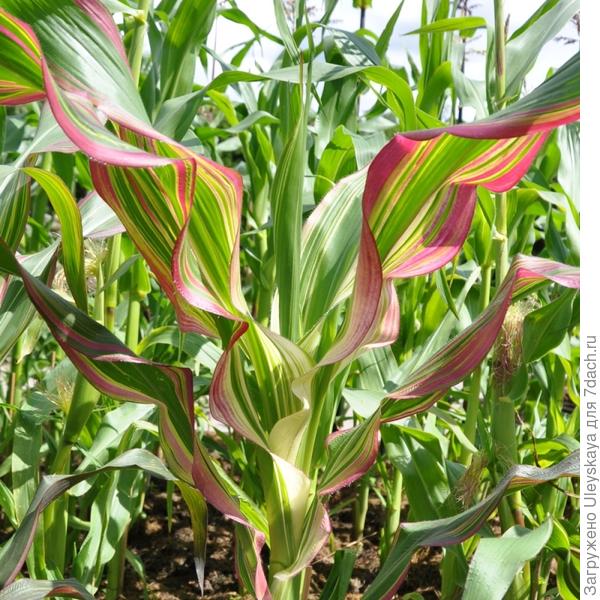

Variegated corn varieties (Zea mays): 'Harlequin' (up to 1.2 m high, leaves are decorated with green, red and white stripes), 'Variegata' (up to 90 cm high, leaves with creamy white stripes) - both of these varieties are excellent suitable for creating a summer variegated vegetable backstage.
What corn prefers, read the articles on the site:
- The attribute of the past summer is corn;
- Corn is both healthy and tasty!
Ornamental cabbage
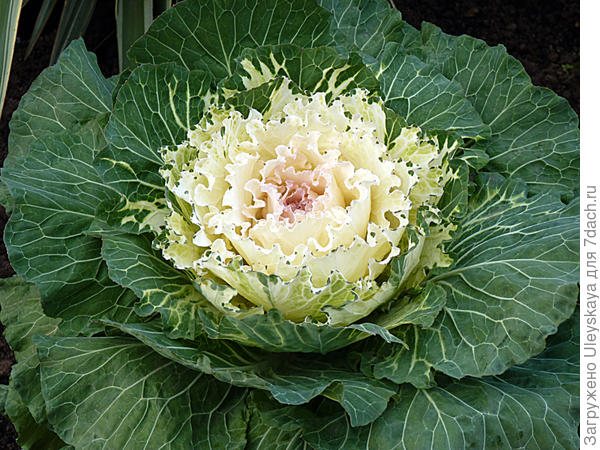

Like a huge rose or "living foam", ornamental cabbage (Brassica subspontanea) attracts close attention. Recently, interesting domestic varieties of VNIISSOK have been bred: Relay, Kraski Vostoka and hybrids with Brussels sprouts, Savoy cabbage and kohlrabi.
Read about ornamental cabbage on the website:
- Winter beauty - decorative cabbage;
- Ornamental cabbage in my garden;
- Spring cabbage surprise;
- Ornamental cabbage.
Sowing salad, golden varieties


Yellow-leaved varieties of lettuce or lettuce (Lactuca sativa): ‘Berlin Yellow’ (leaves are light green, with yellowness), ‘Lollo Bionda’ (leaves are curly, yellowish-green) and others are very interesting and worthy to take their place in a creative dacha. They combine well with bronze, green varieties. Such a mix will look beautiful both on a separate bed and in the foreground, in combined plantings with flowers.
Beneficial features
Despite the fact that foxtail is not considered a pharmacopoeial plant, it still found its use in traditional medicine. First of all, this plant is an analgesic, expectorant and tonic for the treatment of colds. Also, foxtail is good for arthritis, radiculitis and diseases of the excretory system.
This plant is also used in traditional medicine, when taking allergy samples and treating bronchial asthma.
Foxtail has a positive effect on the nervous system. The plant is not recommended for use in the treatment of those people whose body may show an allergic reaction. After all, the pollen of this culture can cause such a disease as hay fever.
Possible difficulties
If agricultural technology is violated, foxtail can suffer from fungal diseases. In damp rooms, leaf spot develops (wet dark brown spots form on the leaves).
In insufficient light, the leaves become pale, almost white. If the tips of the foliage dry out, the air in the room is too dry. The appearance of dark spots on the leaves at moderate humidity indicates drafts or too low temperatures.
Sometimes aphids, whiteflies and spider mites settle on akalif. If parasites are found, the crown is treated with an insecticide.
Application of meadow foxtail
This plant is grown as a forage crop. In addition, foxtail is used for arranging lawns. Also, decorative forms of this plant are often used in the arrangement of rockeries and naturgardens.
In medicine, meadow foxtail, or rather its pollen, is used in the preparation of allergens. Also, from this plant, you can prepare medicinal decoctions, which are capable of providing a general strengthening effect. Dried flowers of culture, florists use when decorating decorative bouquets and compositions.
Decorative use
The genus Foxtail includes more than 70 species of plants that are distributed throughout the world, except for tropical zones. There are 18 representatives on the territory of our country, one of them is used in landscape design for arranging green and even lawns.
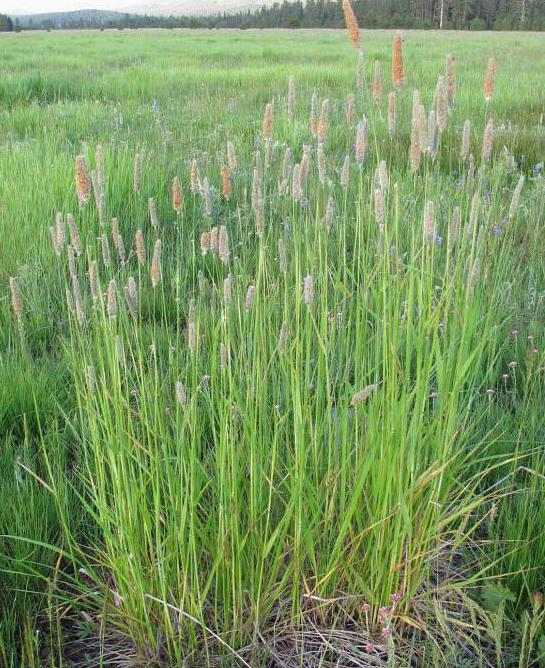

Meadow foxtail is also used in single plantings. For the formation of decorative bumps, variegated forms are chosen. The most common cultivar in culture is Aureovariegatus (or Aureus). It is distinguished by erect, and by autumn, slightly drooping leaves of a golden hue with bright green stripes. In culture, it is stable, non-aggressive, reaches a height of 30 cm, peduncles - 50-100 cm. Regardless of whether you cut or leave spikelets, the bush will turn green in the shade, and retain a yellowish color in the sun.
Planting and leaving
For sowing this crop, it is better to use fresh, drained soil. Before sowing, you need to carry out some preparatory work in the form of treating the soil with herbicides. Two weeks after spraying, the soil must be plowed. If the plant is grown for seeds, then it is better to sow it in even rows. Sowing can be both cover and uncover. Testes can be sown in the fall under winter rye, or under some annual grasses.
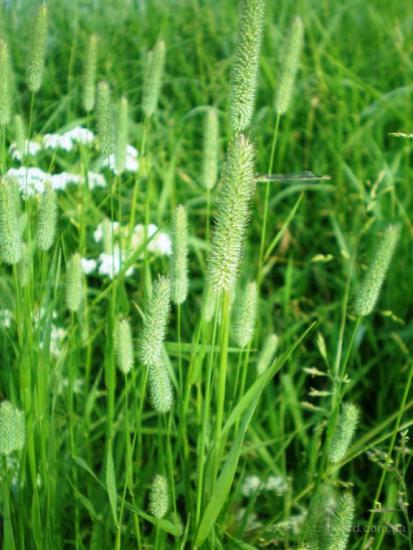

In order for the planted grass stand to be dense, the number of plants per square meter should be 350 pcs. The care of meadow foxtail crops consists of irrigation, fertilization and cultivation. Plant feeding should be done before the start of its growing season. In this case, mineral fertilizers are applied in an amount: 3 centners of superphosphate and 1 centners of potash fertilizers per 1 ha of sowing. Sowing is also fertilized with nitrogen fertilization in the form of ammonium nitrate (1 centner per 1 ha).
Habitat and distribution
Traditionally, the meadow foxtail plant is considered typical of the meadows of northern Europe, which are its geographical homeland. However, at present, it has spread everywhere, with the exception of tropical zones. Very often, in places of growth, it forms dense thickets with sodding of the soil. It grows equally well on marshy and wet meadows, dry lands, forest glades, river and lake banks, pebbles, and is found along the roadsides. It is the predominant plant in the herbage on floodplains of various grasses, together with creeping wheatgrass, bluegrass, and red grass.
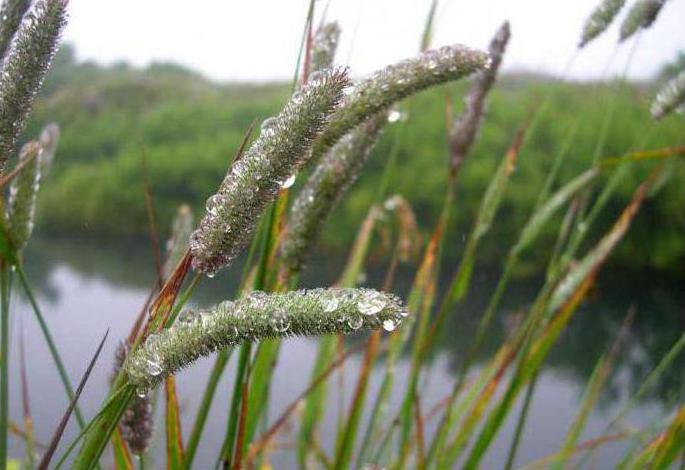

Meadow foxtail soils, the description of which is given in the article, prefers loose, moderately moist, fertile, peat bogs and loams. It can withstand prolonged waterlogging for up to a month, for example, during flooding. However, salinization, stagnant moisture and waterlogging, as well as severe droughts, are detrimental to it.
Harvesting seeds
Seeds of meadow foxtail ripen at the end of June. Harvesting should be carried out when the plant is in the phase of waxy ripeness. This can be determined by the color of the plant when the overall appearance of zero reaches a greenish hue. Also on separate stems, the seeds begin to crumble slightly. The seeds have a soft cutting consistency. Ripe crops are harvested by direct combining.
At the same time, it is necessary to take into account the nuance that it is necessary to harvest plants only from the second year of its fruiting.If foxtail sowing is used for hay, then two mows are carried out per season, and if for grass flour - then three. The amount of harvesting depends on the ability and the length of regrowth of the cut plant. If the height of the cut plant is at least five centimeters, then regrowth will be rapid.
After harvesting, a certain refinement should be carried out with it. A heap of plants is sent for rough cleaning. Such cleaning is carried out for sorting coarse and fine impurities. If the heap is wet, then it must be dried by ventilation. After that, primary and basic cleaning is carried out.
Read also: Why hydrangea does not grow, the main diseases of the flower
Video about a beautiful plant - meadow foxtail:
Her best enemy
Akalifa suffers from spider mites, whiteflies, aphids and scale insects.
| Pests | Manifestations | Fight | Prophylaxis |
| Whitefly | • Leaves wilt. • Greenish larvae on the bottom of the leaf plate | Spray with insecticide (kinmix) twice a week until the whiteflies are gone | Inspect the plant and use insecticides for prevention |
| Shields | • Sticky bloom on yellowed leaves. • Brown plaques | • Wipe the leaves with cotton wool and alcohol, removing pests. • Treat the plant with an insecticide (fitoverm, fufanon) | • Wash low plants under the shower. • Clean the leaves of akalifa Wilks with a damp sponge |
| Spider mite | • The plate has yellow spots and looks dusty. • There is a thin cobweb under the sheet | • Arrange a bush of souls. • Treat with acaricide (actellik). • Humidify the air around the plant | • Spray. • Wash compact plants under the shower |
| Aphid | • Leaves are curled. • Shoots are deformed | • Wash off aphids with warm water and soap. • Treat with insecticide | Spray with an insecticide for prophylactic purposes |
Botanical description
Meadow foxtail (Alopecurus pratensis) belongs to perennial grasses, reaching a height of about 50-110 cm... The bush is densely leafy, has long creeping roots. Stems are elongated and elongated, have a smooth surface. In addition to generative shoots, an adult bush can also have small shoots with fairly long foliage. The leaves of the plant are elongated, narrow, dark green in color, reaching a length of 25 cm.
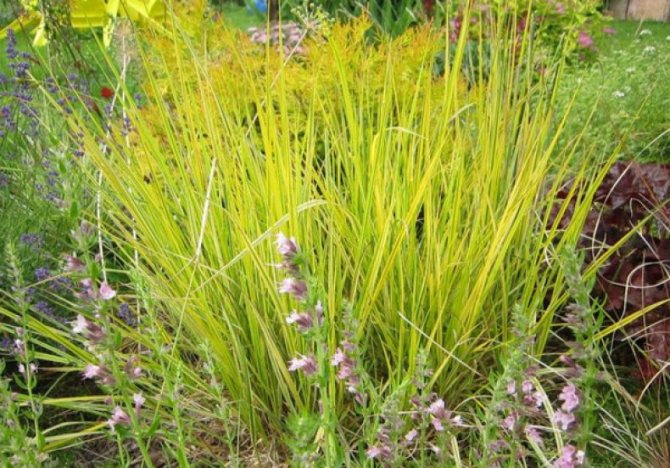

The foxtail begins to bloom in June, and the seeds ripen in July. Since it blooms from 4-5 to 7-8 o'clock in the morning, it is referred to as "morning cereals". The inflorescence is presented in the form of a cylindrical elongated panicle, which has a grayish tint. The length of such an inflorescence is 10-12 cm.
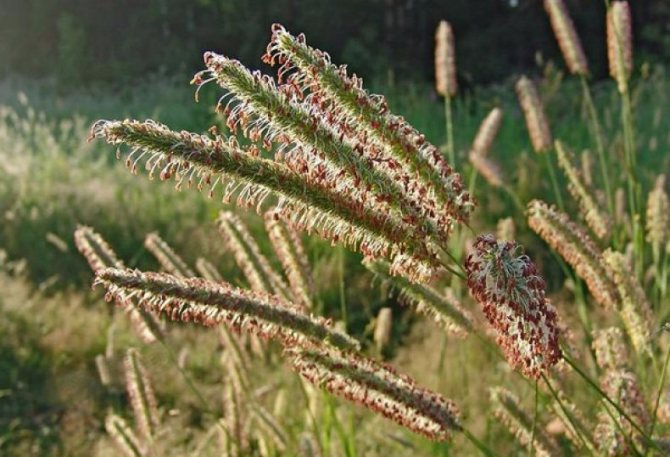

The panicle itself consists of a large number of spikelets, which have a large elliptical shape. The fruit is presented in the form of a flattened caryopsis with a length of 4–6 mm. Foxtail begins to bear fruit as early as the second year after planting, pollination is mainly carried out by the wind. The flowering period of the cereal is 13–17 days.
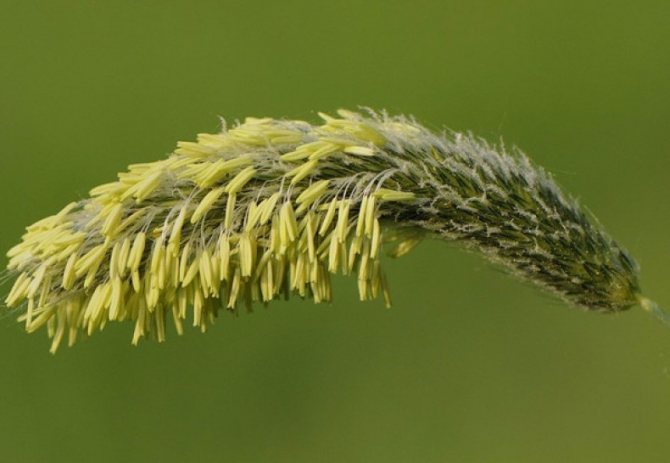

The necessary conditions
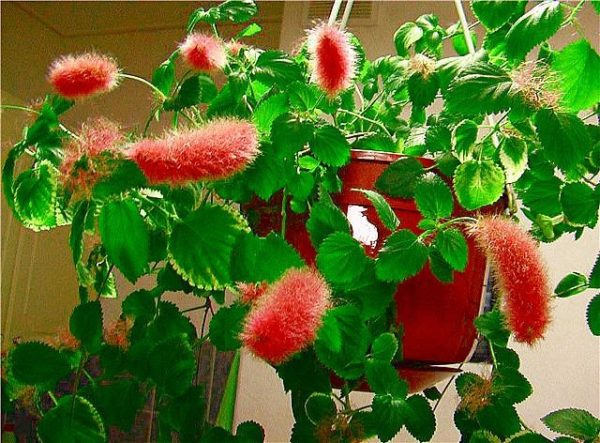

Akalifa cannot be called finicky, but she makes clear requirements both to humidity and air temperature, as well as to lighting.
Living in diffused light
Try to find the bright spot for the plant. In the shade, the color of the Copper Leaf will fade, and the inflorescences of the Fox Tail will diminish. In winter, additional lighting may be required during the evening hours. Do not keep the Akalifa in direct sun - this is fraught with burns and drying out of the soil.
The foxtail is most comfortable in the east or west window. If it is on the south side, shade the bush on sunny days. On the northern windowsill, there is not enough natural light for the foxtail, the stems are stretched, and the leaves turn pale, flowering occurs later, the shades of the "tails" are dimmer.
Application
The popularity of this plant lies precisely in the fact that it can be used in a wide variety of spheres of human activity.
As feed
This cereal is early maturing and is widely used as feed for livestock. Thanks to excellent feeding ability and digestibility animals easily eat it, while receiving all the necessary vitamins and minerals. For this, foxtail is considered one of the best cereals.
This plant produces excellent hay, which is not inferior in quality to other selective crops. It should be harvested at the beginning of the flowering of the cereal. This hay is best suited for cattle, slightly worse for sheep and goats.
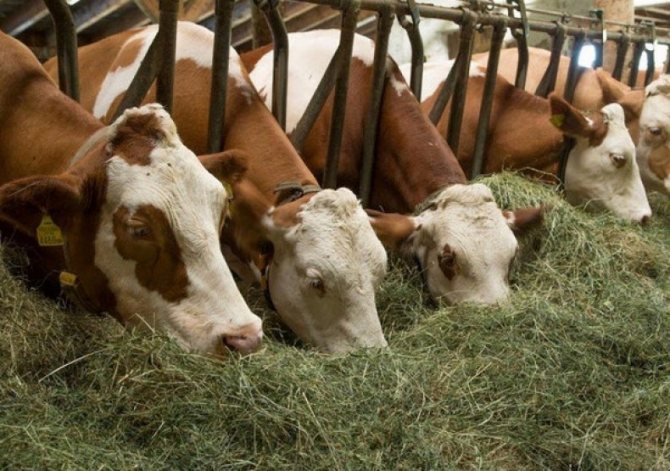

Medicinal plant
In medicine, foxtail is most often used to prepare various decoctions that help in the treatment of various types of diseases. If you are worried about rheumatism or skin diseases, then baths from this cereal will help in the best possible way and will have an effective effect. You can also use a foxtail wrap for colds.
The medicinal properties of this plant are also manifested in improving blood circulation and strengthening blood vessels. In addition, it generally strengthens the entire human circulatory system.
Ornamental plant growing
If you are interested in how to make your garden unusual and attractive, then the use of meadow foxtail will certainly help you. It combines well with other grains to create a stylish and sophisticated design for the entire garden. It is also used to decorate curbs, backyards, flower beds and lawns.
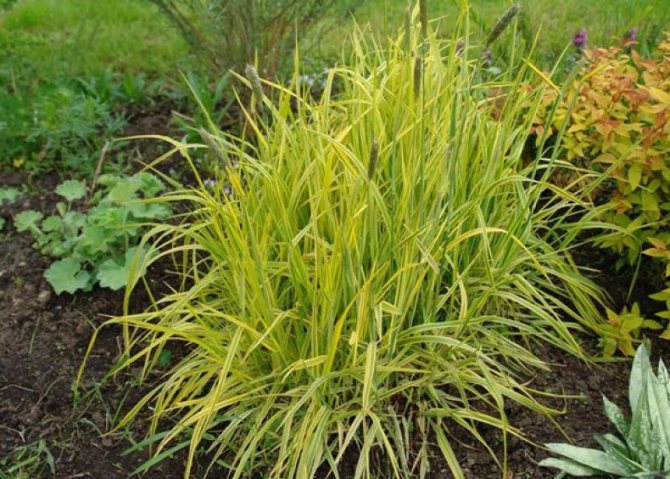

Do not forget about this cereal when creating decorative bouquets - it will perfectly complement the composition, giving it an unusual shape and appearance. Most often, foxtail is used to create lawns, including sports ones.
Photo gallery
The southern habits of the Akalifa will have to be reconciled if you want to decorate your home with this tropical nettle. Although it does not burn the hands, its juice, like many euphorbiases, is slightly toxic. The plant has retained its love for the warm, humid climate of its native places, which is sharply different from the conditions of a modern apartment. Bringing a piece of subtropics into the house, you change its atmosphere and change yourself.
Features of agricultural technology
Meadow foxtail is an unpretentious, but at the same time quite demanding plant. It needs proper care and certain natural conditions.
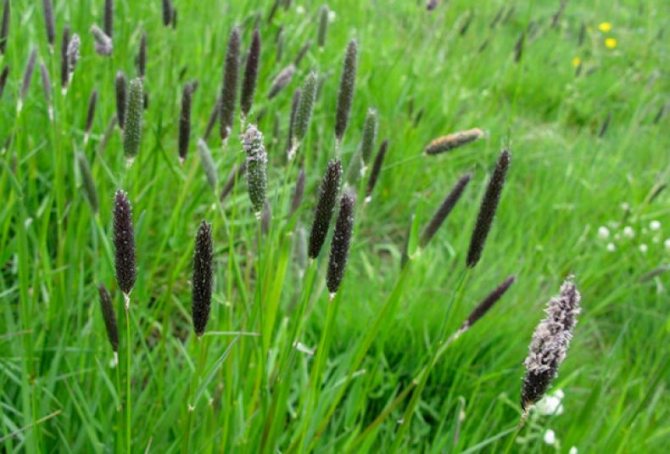

Choice of soil and location
Soil required must be drained and rich in humus... Wet meadows and garden lawns, peat bogs, clay or sandy soils are ideal places for the growth of such a cereal. The plant does not tolerate drought well, the main thing for its successful growth and development is a sufficient level of humidity and good sunlight.
Reproduction and planting
Foxtail propagation occurs in two ways: root cuttings or seeds... Of course, the first method is more common among gardeners, since it is much easier and faster to buy and plant root cuttings in rolls than to grow cereals from seeds, which takes about four years on average.
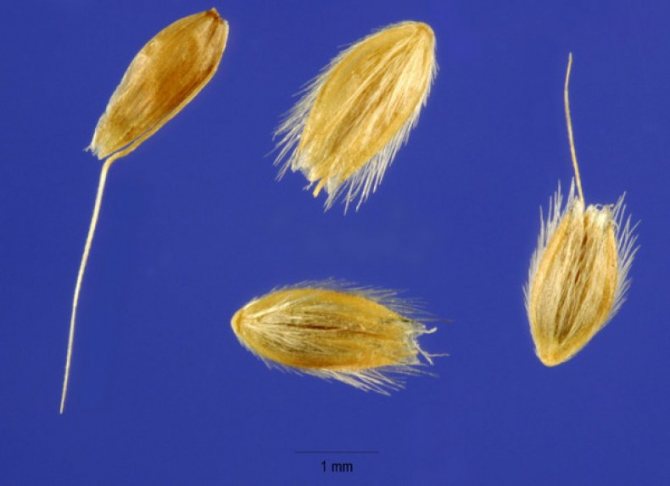

Planting a cereal includes several stages:
- At the preparatory stage, you need to cultivate the soil with herbicides.
- Two weeks after treatment, the soil must be plowed.
- If you are growing a plant from seeds, then sow them in even rows. You can use both cover and coverless sowing.
How to care for your culture
Caring for such a cereal consists of regular watering, fertilization and cultivation.
Read also: Vriezia flower: the most common species
It is necessary to water foxtail crops regularly, as the topsoil dries out. Plant constantly needs hydration: even a slight lack of moisture will lead to a deterioration in its condition and appearance.


Top dressing of the cereal should be carried out even before the beginning of the growing season. Apply mineral fertilizers in the following proportions: superphosphate - 3 centners, potash fertilizers - 1 centners, per 1 hectare of sowing. You can also use nitrogen fertilizers, namely ammonium nitrate at the rate of 1 centner per 1 ha.
Harvest
By the end of June, foxtail seeds ripen. Their harvesting should be carried out only in the phase of waxy ripeness of the given cereal. This period is determined precisely by the color of the plant itself, when it acquires a green tint. At the same moment, some seeds on separate stems begin to crumble. The seeds are light, flat, membranous, and have small stiff thorns.


An important aspect of foxtail harvesting is that it can only be carried out in the second year of its fruiting. Consider also the purpose for which the harvest is taking place. If you want to use it for hay, then do two collections, if for the preparation of grass flour - then generally three. It all depends on the growth rate and length of the cereal. Regrowth will occur quickly if the cut foxtail is at least 5 cm high.
Also, do not forget that the harvested crop needs special processing. To separate large from small impurities, coarsely clean the heap of cereal. If the heap is a little damp, you need to dry it using ventilation. After that, you can carry out the primary and basic cleaning of the collected foxtail.
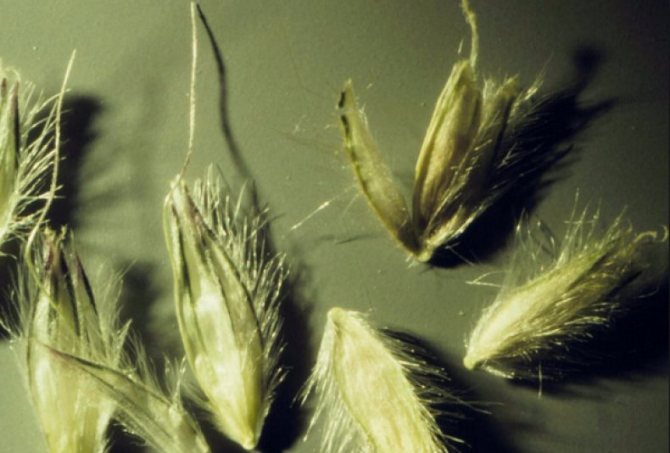

Having learned in more detail and having studied the description of such a plant as meadow foxtail, one can single out a large number of its positive aspects: good germination, unpretentiousness and a wide range of applications. Choosing such a cereal for growing in your garden, you will receive not only an excellent decorative decoration, but also nutritious food for livestock, as well as a plant with unique medicinal and prophylactic properties.
Spring housewarming
Young akalifa is growing rapidly, so transplanting into a larger pot takes place annually at the beginning of March. Do not block the drainage hole with anything: the plant becomes sick due to waterlogging. When replanting, fill in 3 cm of drainage from fine gravel, expanded clay, foam crumbs.
The older the plant becomes, the less often it needs a transplant, no more than 1 time in 3 years. In large specimens sitting in large containers, the surface layer of the earth simply changes.
Since foxtail is often watered, the soil needs to be loose, allowing the roots to breathe. Take equal parts of peat, coarse river sand, leaf humus and sod land. Any commercially available slightly acidic soil will do.
In the meadow ... foxes graze
Meadow foxtail looks amazing as a border.
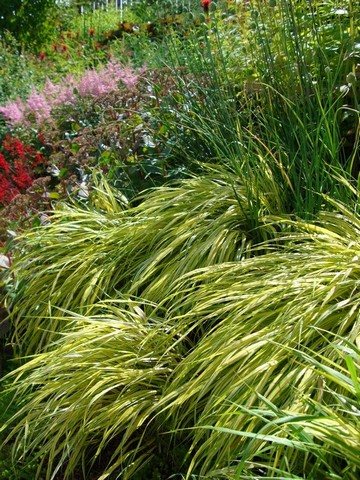

Alopecurus pratrnsis Aureovariegatus
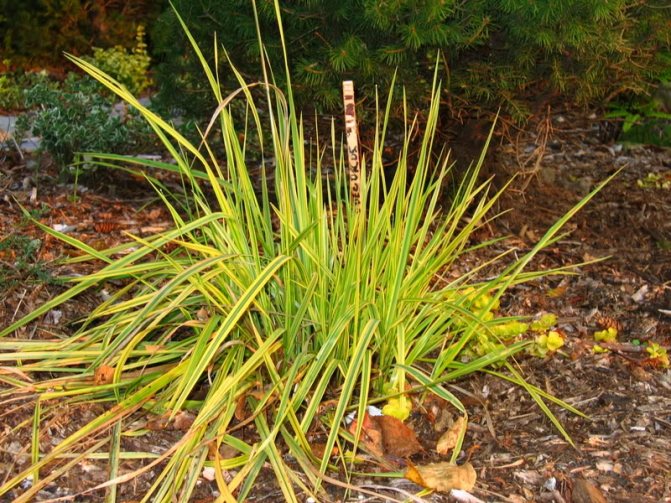

Meadow foxtail of this variety is a short grass, up to 30 cm, plant diameter up to 50 cm, looks great in borders, for lawns, in mixborders, near bushes and trees. Ideal for Naturgarden, Prairie, English Gardens, Heather Gardens. The inflorescences are used for bouquets. In one place it grows well up to 10 years.
Variegated cereals
They are like colorful "living fountains" with very spectacular narrow linear leaves sticking out in all directions. Summer residents have not only looked closely at these perennial grasses from the family of the same name Cereals / Meatlikovye for a long time, but many of them are already successfully grown in their dachas, controlling the growth (sometimes very aggressive).
Calamus cereal 'Variegatus'
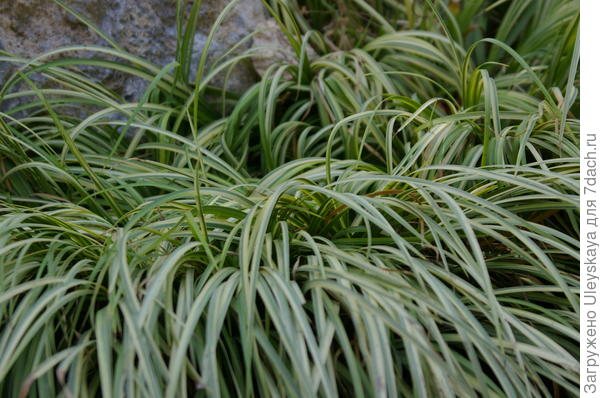

Calamus cereal ‘Variegated’ (Acorus gramineus ‘Variegatus’) is a perennial rhizome plant with narrow linear leaves 8-30 cm long, with longitudinal yellow and cream stripes. It is 25 cm high and up to 15 cm wide. There is another variegated form of this plant - 'Ogon', syn. ‘Wogon’, it is also up to 25 cm high, 10-15 cm wide, with bright yellow stripes on the leaves.
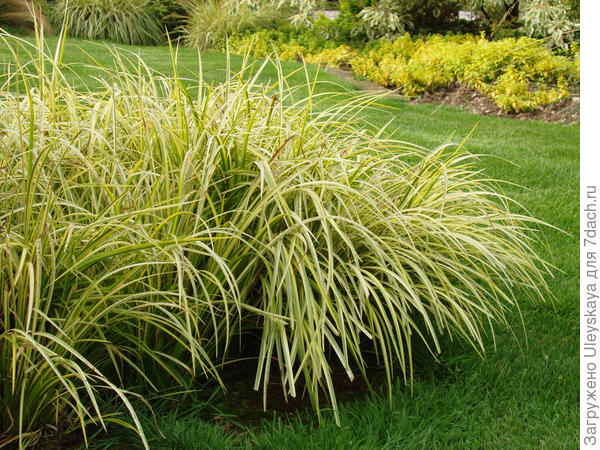

Both calamus grow rapidly in well-lit and semi-shady humid areas.
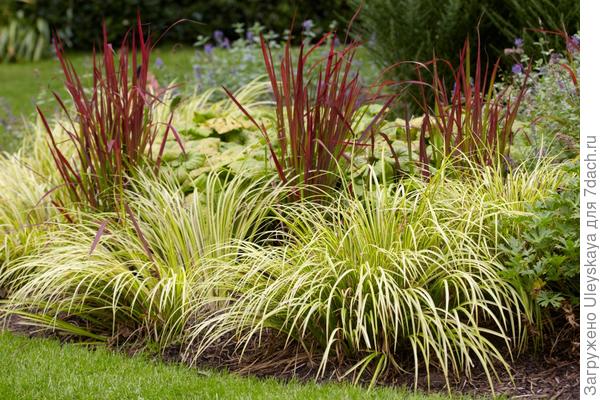

Can be used as coastal aquatic plants.
The appearance of a new hero
Another foxtail is akalifa (Acálypha)... It is a plant from the Euphorbiaceae family. In the west it is called Rabo de gato (Spanish for cat's tail).It got the name (note - this is the popular name) Foxtail for bright fluffy spike-shaped inflorescences. Inflorescences can be bright red or white, of various lengths (up to 50 cm).
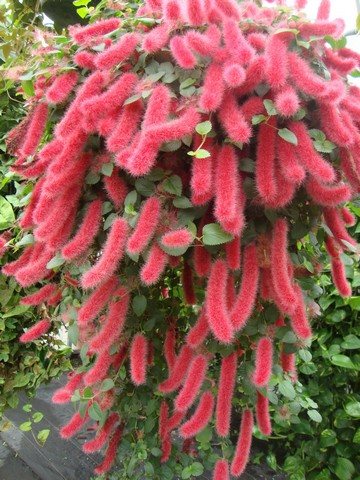

Akalifs are shrubs or small trees as well as herbaceous plants with typical green foliage similar to that of nettle (hence the name Akalifa). Application - indoor floriculture.
The photo of this foxtail is below:
There are miniature Akalifs.
The most popular indoor foxtails are:
- akalifa rough,
- akalif wilks,
- akalifa bristly,
- akalifa bristly-haired (Acalypha hispida).
Caring for this fox tail is also nothing out of the ordinary, a standard requirement of a culture whose homeland is the tropics and subtropics.
A heat-loving plant, room temperature conditions, both in winter and in summer, are ideal for him. Likes abundant diffused light, good watering without dampness (watering is more moderate in winter). He does not like dry air, therefore, very frequent spraying is desirable. Planting - in a universal slightly acidic soil, good drainage is required.
It blooms almost all year round.
The most important points in caring for akalifa:
- Make sure that the soil does not dry out.
- Correct fit to avoid bay.
- Lack of drafts.
- Good lighting without direct sunlight.
Propagated without problems by seeds and cuttings.
As you can see, these two foxtails are not botanically close in any way. They are not connected either by origin or field of application, and even outwardly they are not too similar. They are united only by associations, and the scientific name Foxtail belongs to a meadow plant, and popular rumor called the indoor Akalifa foxtail. Perhaps the reason is that not all Akalifs have fluffy hanging inflorescences, many of these plants are distinguished by bright, decorative foliage, and their flowers are more than modest.
Read also: Mussenda is a beautiful and original flower
White and fluffy
The crimson foxtail has a variety with white inflorescences, a kind of polar fox - Akalifa Alba (A. alba).
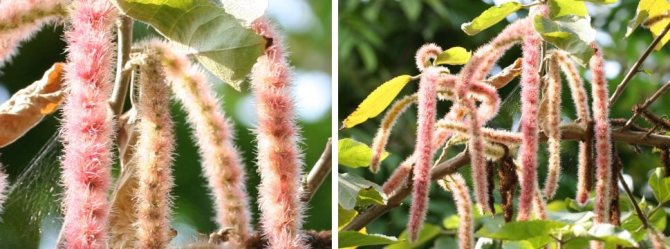

From the point of view of feng shui, foxtail harmoniously combines yin and yang, strength and weakness. Its inflorescences are bright as the rising sun, but sadly droop down. By bringing an akalifa to your home, you will help women strengthen their leadership qualities, and men become more tender. Rational people learn what the life of the heart is, and sensitive people begin to live with their heads.
The juice of any kind of akalifa is poisonous. If there are children or animals in the house who are partial to indoor flowers, make sure that they do not try to chew on its leaves. In other cases, the plant is completely harmless.
Lighting
Akalifa is very fond of light, but direct rays of the sun are unacceptable. Lighting should be diffused.
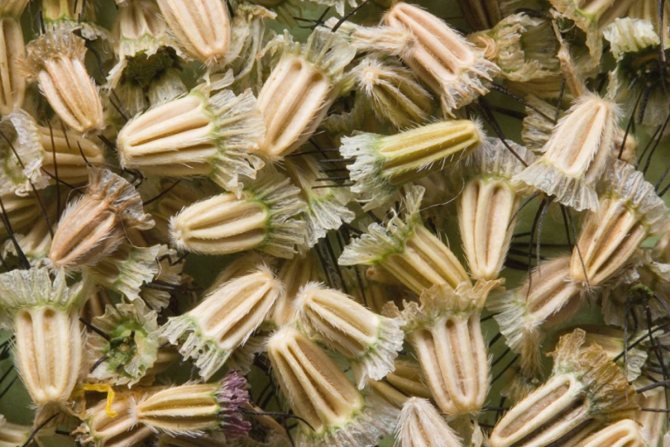

With sufficient lighting, Akalifa grows more intensively and blooms more, and with a lack of it, the leaves fade, and the stem stretches up.
If the flower is on the south window, then shading from the sun should be done at noon.
East and west windows are the best choice in the spring and summer.
From the end of autumn and into winter, it is good to add a phytolamp to the illumination of the plant. Akalifa should receive 7-8 light hours a day.
Watering
In summer, when the temperature begins to exceed 20 ° C, watering the Akalif is required often and a lot. The heat dries up the air, so spraying is necessary.
The soil in the pot should not dry out, and the excess water from the pan should be drained.
In winter, it is necessary to reduce watering, because excess moisture in cool air can lead to disease. But the earth should not dry out.
Soft and slightly warm water is best for watering.
Important! The soil in the pot should be loosened after each watering.
Types and varieties
The total number of the genus is about 70 species, of which 18 grow in the vastness of Russia.
Meadow foxtail


Meadow foxtail (Alopecurus pratensis L.)
Meadow foxtail (Alopecurus pratensis L.) is a cereal perennial up to 120 cm high, with a short rhizome. The inflorescence resembles a cylinder in shape, up to 10 cm long, with short twigs adjacent to the axis. Spikelets are tiny, up to 5 mm long, elliptical. Leaves are bright olive green, velvety, erect or drooping. Blooms in June, begins to bear fruit by July.
Meadow foxtail lives on flooded meadows, forest edges, along rivers and lakes, along damp ditches and roadsides. It propagates and spreads mainly by seeds. Meadow foxtail is an excellent forage grain, it grows back quickly after mowing.
The plant winters well without shelter and therefore, of course, is suitable for growing in the garden, without causing much trouble for flower growers.
The species plant looks rather inconspicuous, so many growers plant its more spectacular variety of meadow foxtail "Aureovariegatus" (Aureovariegatus). Its leaves are lemon-colored, decorated with green stripes. The variety is up to 30 cm high, non-aggressive and stable in culture. Spikelets are first olive green, then chestnut, cylindrical in shape.
Representatives of this variety look very attractive, therefore, with them, they create picturesque compositions based on the contrast of color and foliage. The combination of the foxtail "Aureovariyegata" with the bright coral leaves of the barberry, the catchy turquoise foliage of the tenacious is especially fascinating to the eye.
Mousetail foxtail
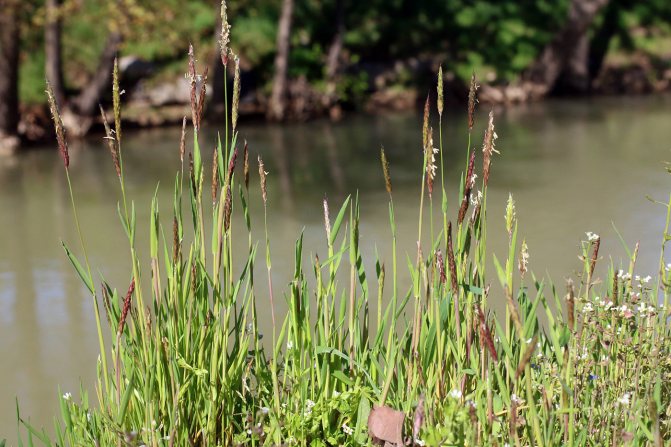

Mousetail foxtail (Alopecurus myosuroides Huds.)
The mouse-tailed foxtail (Alopecurus myosuroides Huds.) Is a perennial plant up to 40 cm high. The stems are ascending or straight. Narrow inflorescence up to 7 cm long, narrowed on both sides. Leaves up to 6 mm wide, with a pointed tip. The flowering period begins towards the end of spring, bears fruit in June-July. The habitat of the mousetail foxtail is concentrated along the roads, along the river banks. Propagated by seeds.
Alpine foxtail
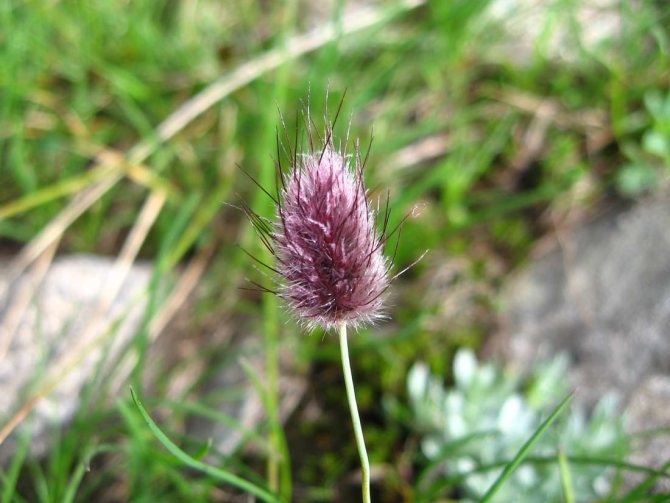

Alpine foxtail
Alpine foxtail is a perennial low arctic plant up to 20 cm high. The inflorescence is spike-shaped, oval or cylindrical, framed by smoky hairs. Spikelets fit tightly to each other. Blooms in July. Looks like loose turf, grows slowly. The color is gray-blue, young shoots are slightly crimson. Prefers a sunny location, well-drained soil. The plant is amazingly suitable for alpine gardens, but its distribution must be controlled.
Temperature
Temperature conditions in most apartments are good for akalifa. Akalifa tolerates temperature fluctuations from 18 ° C to 26 ° C. But it blooms best in the 22-24ºC range.
In summer it is permissible to increase the temperature up to 27 ° C, and in winter - a decrease to 17 ° C. In summer, the Akalifa should be taken out to the balcony or terrace if they are located in the east or west. If the nights are warm, then it can be left there until cold snaps.
Attention! Drafts are unacceptable - the plant may die.
Field variety
The plant is a species of foxtail, however, it is considered a weed. Foxtail loves sufficiently moist fertile soils with a high carbonate content. The plant blooms from May to mid-summer. Smooth stems with flat leaves grow in bunches from the fibrous root. Seeds germinate with the onset of spring, but can germinate in summer and even autumn. The field foxtail is able to withstand frost, grows to about half a meter. The leaves are soft and narrow at the base, without lint, curling in a spiral.
Medical use


Meadow foxtail grass is mowed in summer, cleaned of coarse parts, dust, earth is removed and dried in a well-ventilated room. Leaves and thin stems with inflorescences are stored in bags, glass or wooden containers for 3 years.Traditional healers use a useful herb to relieve pain, facilitate the release of phlegm from the respiratory tract, and fully ensure the healthy life of the immune system.
Extracts based on foxtail are used to treat viral diseases affecting the mucous membrane of the upper respiratory tract, diseases of the spinal nerve roots, inflammation of the joints, pathologies of the urinary system.
Meadow foxtail is used by allergists during allergy tests, as well as a remedy for the treatment of seasonal allergic rhinoconjunctivitis, chronic inflammatory diseases of the respiratory tract. Foxtail is useful for neuroses, as well as for diseases and specific conditions in which blood clotting is impaired, the state of blood vessels and capillaries deteriorates. Foxtail grass is used externally in the form of bandages to relieve pain and get rid of paroxysmal, involuntary muscle contractions as a result of their overstrain.
The plant, like other wild-growing cereals, is able to stimulate blood circulation in the body, to help strengthen blood vessels. An excellent tool for raising immunity, increasing efficiency, preventing colds are herbal wraps. For diseases of the joints and muscles with damage to the cardiovascular system, stress disorders, skin problems, herbal baths with foxtail extract are indicated. With inflammation of the bladder, kidney diseases, it is effective to take decoctions of foxtail herb.
The plant is not useful for everyone: the foxtail has a harmful effect on people suffering from allergic reactions. Foxtail pollen during flowering can cause acute inflammation of the mucous membranes of the eyes, skin and respiratory tract. Sometimes, while the plants are blooming, with allergies to foxtail and other herbs, digestive dysfunctions are observed, the nervous system and hematopoietic organs suffer.
Chemical composition
The dried parts of the plant contain proteins, calcium, phosphorus, carotene, flavonoids.
Formation
All Akalifs are fast-growing plants, therefore, in order to give a more magnificent shape, young Akalifs need to be pinched, while removing the buds from the upper shoots. In order to update an adult plant, all the shoots are cut off from them, leaving only hemp 25-30 centimeters high, after this cutting, the plant must be constantly sprayed, you can put a transparent plastic bag on it for better adaptation.
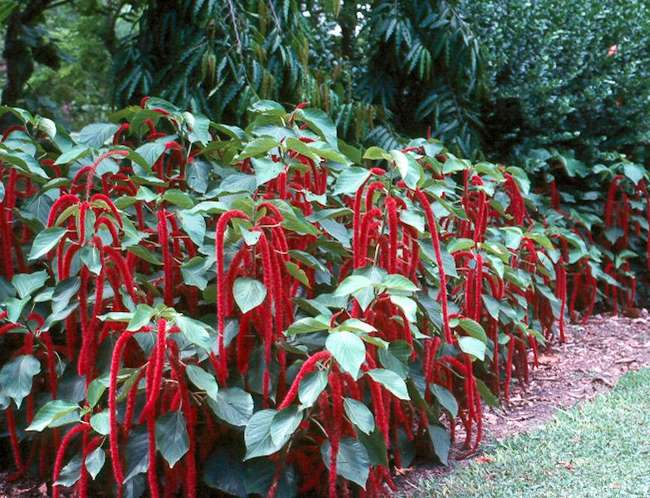

When working with plants, you must remember that all parts of Akalifa contain toxic substances!
Akalifa home care
Akalifa prefers a warm and humid climate, for this it is necessary to optimize the temperature all year round in the region from 18 to 25 degrees. Lighting for the plant needs to be bright, but not under bright rays, if directed rays can fall on the flower in the sultry heat, then it is necessary to make an artificial shadow. Watering Akalif prefers regular, moderate in the warm season, and in winter, the moisture is reduced. Water for irrigation needs soft and settled for a day and the water temperature is about 20. Akalif should be sprayed from a sprayer, since overdried air has a detrimental effect on the plant.
Soil for Akalifa needs nutritious and slightly acidic. You can purchase ready-made soil or prepare it yourself by taking in equal parts sod soil, humus, peat and sand. It is imperative to lay drainage on the bottom. Fertilization is necessary for the plant throughout the warm season. Mineral fertilizer is suitable for this. Top dressing must be done once every 21 days. The plant must be transplanted as needed in the spring. Akalifa does not require a complete transplant, since its root system is not large, but simply replace the top layer of soil.When transplanting and just once every few years, it is necessary to prune the plants, for the appearance of new stems, pruning the stems in adults, by about 25 centimeters.
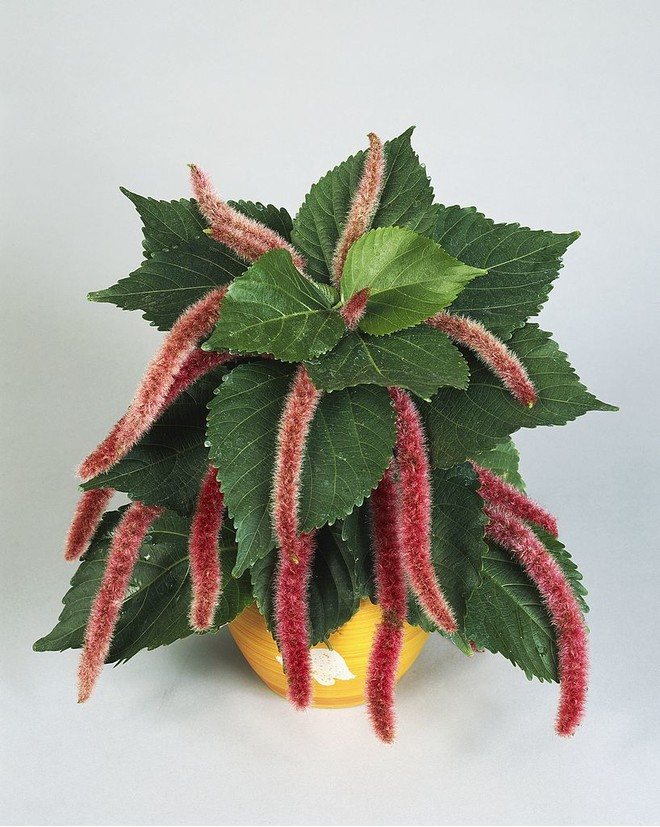

Loading ...
Table: how to create the correct microclimate Akalife
| Factor | Recommendations |
| Location | Sill of a window facing southeast or southwest, or at some distance from the south window. It is not recommended to take out the flower outdoors, even in summer. Regular airing is mandatory. |
| Lighting | You need a bright, but diffused light. Shade the plant during the period of greatest solar activity (11: 00-14: 00). In winter, use special phyto- or conventional fluorescent lamps to extend the daylight hours at least up to 10-12 hours. The brighter the leaves of the Akalifa, the more light it needs. This also applies to variegated varieties that lose their color in the shade. |
| Temperature | In summer - 20-25 ° C, in winter - 17-20 ° C. At temperatures above 35 ° C and below 15 ° C, the flower may die. Akalifa does not like sudden changes in temperature, as well as cold drafts. If it is not possible to ensure the optimal temperature in winter, watering should be more frequent than during the dormant period. |
| Air humidity | The minimum indicator is 65% (preferably 70–80%). It is advisable to spray the flower every day (in the heat - 2-3 times a day) and create a suspension of water droplets in the air around it. In the summer, an additional container with water is placed next to it, wet pebbles or expanded clay are poured into the pallet, the soil in the pot is covered with wet moss, coconut fiber. Do not just pour water into the pan - this provokes the development of rot. |
Table: how a flower reacts to improper care
| What does a plant look like | What is the reason and how to solve the problem |
| The stems are elongated, the leaves become smaller and fade. | The flower lacks light. You need to find another place for the pot or use lamps. The Akalif is gradually taught to new conditions. |
| The leaves turn yellow, the tips turn brown and dry. | The soil in the pot dries out frequently and severely. Establish proper watering. |
| The leaves lose their tone, numb, the surface becomes wrinkled. | The plant is not watered correctly. The described situation occurs both with an excess and a deficit of moisture. Or it is “to blame” for the unsuitable for akalifa, too heavy, poorly water-permeable soil. |
| Brown "weeping" spots appear on the leaves, the bases of the petioles and shoots turn black. | The cause of the developing rot is frequent abundant watering in combination with a low temperature in the room or cold drafts. |
| Leaves dry and fall off. | If the process is not too intense and only affects the lower leaves, this is normal. Otherwise, the plant suffers from nutrient deficiencies in the soil or low air humidity. |
Diseases and pests
If weeping brown spots appear on the leaves, then the cause of this is leaf spot disease. If the leaves wither, then the reason lies in the excessive moisture of the soil or its overdrying. It is important to adjust the watering. Another reason is the overly heavy substrate. It should be replaced. When the leaves lose their color, become pale, this indicates a lack of lighting. if the akalifa has been in shade for a long time, then it must be gradually accustomed to more light.
In winter, the plant needs fluorescent lighting. The tips of the leaves have become dry and brown - too low indoor humidity or insufficient watering. Dark spots have appeared - the cause is drafts and hypothermia. Advice! The toxicity of the plant is important to consider if there are small children and pets in the house. Among pests for Akalifa, the danger is represented by: aphids, spider mites, whiteflies, mealybugs. They are treated by applying insecticides (spraying and watering), for example, Aktara.
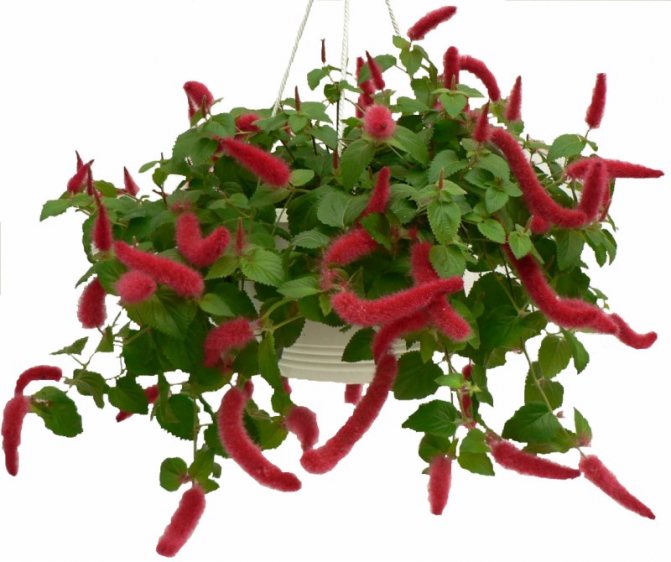

Table: what pests akalifa suffers from
| Pest | External manifestations | How to fight? |
| Aphid | Insects settle on the plant in colonies, clinging to the tops of the shoots, buds and the inside of the leaves.Plants are covered with small beige dots, clearly visible in the light. |
|
| Whitefly | Insects, similar to small moths, soar into the air, it is only necessary to lightly touch the flower. On the seamy side of the leaf there are clutches of eggs and almost colorless spots of irregular shape. |
|
| Spider mite | Petioles and shoots braided with thin, almost imperceptible threads. The reverse side of the sheet is covered with whitish spots, from above it becomes discolored. |
|
| Mealybug | Small off-white lumps on the plant, like fluff or cotton wool. The substrate at the edges of the pot pulls away, revealing a ring of whitish, wax-like substance. |
|
| Shield | Red or yellow patches of tissue around dull brown oval growths; almost black substrate. |
|
Signs and advice from readers
Since ancient times, Akalifa has been considered a plant of joy. It is recommended to place it in dwellings in which people are constantly depressed. Akalifa is able to accumulate positive energy in herself, and then at the right time to distribute it throughout the room. Also, this flower provides a person with inner harmony, develops sensitivity and logic, improves mutual understanding in the family.
Some people believe that Akalifa is able to take energy from people living in the house. This phenomenon is argued by the feng shui theory of yin and yang. In fact, this phenomenon is due to the fact that the pollen of Fox Tail catkins is able to have a relaxing effect. This is what is considered to be a decline in strength and the "invasion" of negative energy.
Akalifa is an exotic plant that requires compliance with all care rules. Its flowers are unique in their kind. Florists do not disregard the fact that Foxtail accumulates positive energy, which many sometimes lack so much.
Plant transplant
Young Akalifs are transplanted every year, while adult specimens are transplanted every 3 or 4 years, if Akalifa has lost its decorative effect, then it is necessary to update by rooting cuttings.
The soil mix for growing Fox Tail should be light and permeable to air and water. Composition: turf, leafy soil, sand, high moor peat, taken in equal proportions.But in different sources of information on the substrate, the ratio of parts fluctuates in these ranges: 4 parts of sod land, 2 parts of greenhouse, 1 part of leafy, and sour high-moor peat or 0.5 sand and one part of leafy land and sand.

